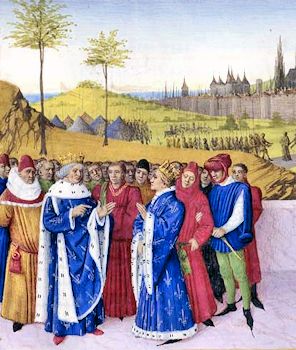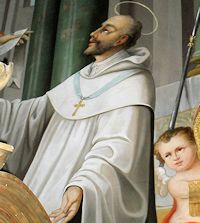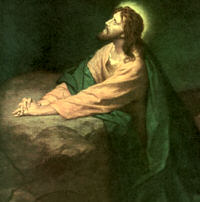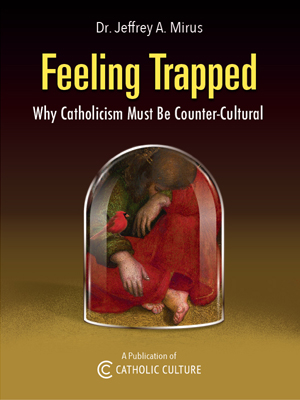Lent: March 28th
Monday of the Fourth Week of Lent
Other Commemorations: St. Gontran, King (RM; St. Stephen Harding, Abbot (RM) ; Other Titles: St. Contran or St. Guntramnus or Guntram
» Enjoy our Liturgical Seasons series of e-books!
Entrance Antiphon, Cf. Ps 31 (30):7-8:
As for me, I trust in the Lord. Let me be glad and rejoice in your mercy, for you have seen my affliction.
During the next two weeks the Gospel for each Lenten weekday Mass is from St. John. We shall read, day after day, about the growing hostility against Jesus that climaxed in the horror of Good Friday. The tragedy begins today on a happy note—a continuation of yesterday’s Laetare Sunday spirit. —The Vatican II Weekday Missal
The Roman Martyrology today honors St. Gontran, also known as Contran or Guntramnus. He was the son of King Clotaire and the grandson of Clovis I. He was raised pagan and became King of Orleans in 561.
According to the former calendar (1962), today is the feast of St. John of Capistrano whose feast is currently celebrated on October 23.
Meditation on the Liturgy
In the first reading of today's Mass, the prophet Isaiah offers a vision of the Messianic Age, which Jesus proclaimed to have begun in himself and by his ministry. The Easter "surprise" toward which the Forty Days leads pilgrims is that this Messianic Age, the Kingdom or Reign of God, will break into history in a wholly unexpected, even counterintuitive, way: it will be established through a new Passover marked by the Cross, the Resurrection, the Ascension, and the sending of the Holy Spirit at Pentecost. And as a result, a new People of God that embraces both Jews and Gentiles will be born into history. For now, Jesus gives another sign of the inbreaking of the Kingdom in today's gospel reading, the cure of the royal official's son. The official, like all disciples, must abandon himself to the divine will: As Father Benedict Bro, a Dominican, put it, "God is God only when I accept the fact that I need him."
Another Dominican, Bede Jarrett, developed the same theme in a way that sheds more light on the imitation of Christ, the obedient Son, to which this phase of the Forty Days calls us:
This life of ours…is a gift from God. It is not of our choosing. It comes to us by his choice. Since it is of his choosing, it is of his designing. We neither made ourselves nor can we manage ourselves as we like, nor manage the life that comes to us. For that reason we can take a most helpful view of life….[For] the thought that it is his gift and after his design gives us courage. If to this remembrance of God's creatorship we add the mystery of the Resurrection, we shall take even larger draughts of hope; for not only life but life's triumph lies entirely in the hands of God
—George Weigel, Roman Pilgrimage
St. Gontran or Guntramnus
 St. Gontran was the son of King Clotaire and grandson of Clovis I and Saint Clotildis. When Clotaire died in 561, his domains were divided among his four sons. While Gontran's brother Caribert reigned at Paris, Sigebert in Metz, and Chilperic in Soissons, he was crowned king of Orleans and Burgundy in 561. He then made Chalons-sur-Saone his capital.
St. Gontran was the son of King Clotaire and grandson of Clovis I and Saint Clotildis. When Clotaire died in 561, his domains were divided among his four sons. While Gontran's brother Caribert reigned at Paris, Sigebert in Metz, and Chilperic in Soissons, he was crowned king of Orleans and Burgundy in 561. He then made Chalons-sur-Saone his capital.
When compelled to take up arms against his ambitious brothers and the Lombards, he made no other use of his victories, gained under the conduct of a brave general called Mommol, than to give peace to his dominions. The crimes in which the barbarous habits of his nation involved him, he effaced by tears of repentance. The prosperity of his reign, both in peace and war, condemns those who suppose that human policy cannot be determined by the maxims of the Gospel, whereas the truth is just the contrary: no others can render a government so efficacious and prosperous.
Saint Gontran always treated the pastors of the Church with respect and veneration. He was the protector of the oppressed, and the tender parent of his subjects. He gave the greatest attention to the care of the sick. He fasted, prayed, wept, and offered himself to God night and day as a victim ready to be sacrificed on the altar of His justice, to avert His indignation, which Saint Gontran believed he himself provoked and drew down upon his innocent people. He was a severe punisher of crimes in his officers and others, and by many wholesome regulations he restrained the barbarous licentiousness of his troops, but no man was ever more ready to forgive offenses against his own person. With royal magnificence, he built and endowed many churches and monasteries.
This good king died on the 23rd of March in 593, in the sixty-eighth year of his age, having reigned thirty-one years.
—Excerpted from Little Pictorial Lives of the Saints, a compilation based on Butler's Lives of the Saints and other sources by John Gilmary Shea (Benziger Brothers: New York, 1894).
Patronage: Divorced people; guardians; repentent murderers
Symbols and Representation: king finding treasure and giving it to the poor; king with three treasure chests, one of which has a globe and cross
Highlights and Things to Do:
- Read more about St. Gontran:
- He was buried in the Church of Saint Marcellus, which he had founded in Chalon. Almost immediately, his subjects proclaimed Gontrand a saint and the Catholic Church celebrates his feast day on 28 March. The Huguenots scattered his ashes in the 16th century. Only his skull remains in the Church of St. Marcellus in a silver case.
- See the print from 1636 in the Met Museum of St. Gontran.
St. Stephen Harding
 Stephen Harding, son of an English noble, was born at Sherborne in Dorsetshire, England, about the middle of the eleventh century. He consecrated himself to the monastic life in the Abbey of Sherbonne in Dorsetshire, where he received his early education. He later studied in Paris and Rome, where he pursued a brilliant course in humanities, philosophy and theology.
Stephen Harding, son of an English noble, was born at Sherborne in Dorsetshire, England, about the middle of the eleventh century. He consecrated himself to the monastic life in the Abbey of Sherbonne in Dorsetshire, where he received his early education. He later studied in Paris and Rome, where he pursued a brilliant course in humanities, philosophy and theology.
After studying in Paris and Rome, he visited the monastery of Molesmes. Impressed by its leaders, Robert of Molesmes and Alberic (who were later canonized), Stephen joined the community.
After a few years, the three men, along with another 20 monks, established a more austere monastery in Citeaux. Eventually, Robert was recalled to Molesme (1099), Alberic died (1110), and Stephen was elected abbot.
Stephen Harding is credited with writing the famous Carta Caritatis (Charter of Charity—often referred to as the Charter of Love). It was a six page constitution which laid out the relationship between the Cistercian houses and their abbots, set out the obligations and duties inherent in these, and ensured the accountability of all the abbots and houses to the underlying themes of charity and living according to the rule of Benedict.
Since the monastery received very few novices, he began to have doubts that the new institution was pleasing to God. He prayed for enlightenment and received a response that encouraged him and his small community. From Bourgogne a noble youth arrived with 30 companions, asking to be admitted to the abbey. This noble was the future St. Bernard. In 1115 St. Stephen built the abbey of Clairvaux, and installed St. Bernard as its Abbot. From it 800 abbeys were born.
In 1133, Stephen resigned as the head of the order, due to age and disability, and died the following year.
—Excerpted from Catholic Fire
Highlights and Things to Do:
- Read more about St. Stephen Harding at EWTN and CatholicSaints.info.
- Read Carta Caritatis.
- Learn more about the Cistercians.






